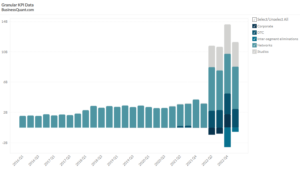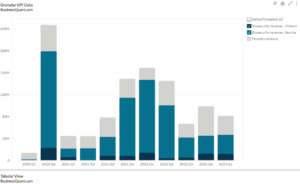
General Mill’s Revenue by Customer (2014-2023)
Exclusive Data
You need the Pro Plan to access KPI data
- Full access to the platform
- KPI data & segment financials on US stocks
- Financial data on thousands of stocks
- Download data in xlsx and csv formats
Pro Plan
$49 per month*
60% discount ends in:
.
About
More information
Subscribe to Pro or Enterprise plans to unlock this feature.
Contact the Analyst
Subscribe to Pro or Enterprise plans to unlock this feature.
Become a smarter investor today.
Access KPIs & Segment Financials on US stocks
This statistic highlights General Mill’s Revenue by Customer, split across Walmart, and Others, reported annually from 2014 onwards.
General Mill’s Revenue by Customer
| Revenue by Customer | 2018 | 2019 | 2020 | Contribution in 2020 |
| Walmart | $3.31 | $3.37 | $3.70 | 21% |
| Others/Unclassified | $12.43 | $13.49 | $13.93 | 79% |
| Total | $15.74 | $16.87 | $17.63 | 100% |
(All figures are in billions, except for percentages.)
During the fiscal year of 2020, Walmart Inc. and its affiliates contributed 21% to the revenue of General Mills in 2020. No other individual customer comprises of 10% or more of General Mill’s consolidated net sales.
The company’s revenue has kept on increasing since 2016. The revenue first increased from $15.74 billion in 2018 to $16.87 billion in 2019, making an increment of 7.17%. Further, it increased from $16.87 billion in 2019 to $17.63 billion in 2020, making an increment of 4.5%. Between the years of 2018 and 2020, the revenue witnessed a growth of 12%, from $15.74 billion to $17.63 billion.
The company generates its revenue primarily from the net sales. Net sales and organic net sales were basically equivalent to the same period last year. However, the slight incline was primarily driven by a decrease in restructuring expense in the fiscal year 2020 and the divestiture loss recorded in the fiscal year 2019, partially offset by greater selling, general, and administrative (SG&A) expenses in the financial year 2020.
General Mill’s revenue by customer can be bifurcated into the following segments:
Walmart
Walmart is an U.S. based multinational company that operates a chain of grocery stores, super markets, and departmental stores in the United States. General Mill uses broker and distribution arrangements for specific products and to serve certain types of consumers and certain markets. Hence, Walmart serves such customer for General Mills.
The contribution of Walmart to the company’s total revenue for the year 2020 stood at 21%. Revenue from Walmart slightly rose from $3.31 billion in 2018 to $3.37 billion in 2019, making an increment of 1.81%. It further increased from $3.37 billion in 2019 to $3.70 billion in 2020, marking an incline of 9.8% on a year-on-year basis. Between 2018 and 2020, the revenue increased from $3.31 billion to $3.70 billion, marking a growth of 11.7% in 2 years.
Others/Unclassified
Customers other than Walmart are included in this category. The company generally sells to these customers through its direct sales force. General Mill’s primary customers are grocery stores, mass merchandisers, membership stores, natural food chains, drug, dollar and discount chains, e-commerce retailers, commercial and non-commercial foodservice distributors and operators, restaurants, convenience stores, and pet specialty stores.
The maximum of the total revenue of the company is generated by the other customers, with a contribution of 79%. Revenue from the other customers grew from $12.43 billion in 2018 to $13.49 billion in 2019, making an increment of %. It further increased from $13.49 billion in 2019 to $13.93 billion in 2020, indicating a rise of 3.2% on an annual basis. Moreover, between 2018 and 2020, the revenue also grew by $1.5 billion, or by 12% from $12.43 billion to $13.93 billion.
About General Mill Inc.
General Mill was incorporated in June, 1928 by James Ford Bell, established in Minnesota, United States. It is a primary worldwide producer and retailer of branded consumer foods sold through retail stores. It is also a main provider of branded and unbranded food products to the North American foodservice and commercial baking industries. General Mill is also a leading manufacturer and marketer in the wholesome natural pet food category. It manufactures products in 13 countries and markets them in more than 100 countries.
The company operates its business under five operating divisions: North America Retail; Convenience Stores & Foodservice; Europe & Australia; Asia & Latin America; and Pet. The business is focused on the large, global categories, including snacks, ready-to-eat cereal, convenient meals, yogurt, wholesome natural pet food, super-premium ice cream, baking mixes and ingredients, and refrigerated and frozen dough. Its Cereal Partners Worldwide (CPW) joint venture with Nestlé S.A. (Nestlé) competes in the ready-to-eat cereal category in markets outside North America, and its Häagen-Dazs Japan, Inc. (HDJ) joint venture challenges the premium ice cream division in Japan.
Did you like General Mill’s Revenue by Customer statistic?
Access more such KPI data points and segment financials on thousands of US stocks, with Business Quant.
You can get started here.
More data on US Stocks

Our Plans
Always know what you’ll pay. No hidden costs or surprises.
- Annual
- Monthly
60% discount till April 30
Pro
For serious investing
-
Company KPI data Access segment financials, non-GAAP metrics and KPI data from presentations and filings. Examples include financials by segment / region / product category, AT&T's broadband subscriber trends, Tesla's deliveries by model and lots more.
-
Stock research tools Features include : stock screener, stock comparison, industry financials, stock warnings, advanced charting tools, timeseries tables, scatter charts, financial statements, stock reports, SEC filings, stock ratings, institutional and insider ownership data. There are 200+ financial items and ratios on thousands of US stocks.
-
Industry data & tools Access premium operating data on 40+ industries. Examples include market share, smartphone shipments by vendor, subscribers by wireless carrier, historical gold production. There are 20,000+ such statistics.
Enterprise
For tailored workflows
-
All of Pro plan Get unfettered access to all our dashboards and dossiers.
-
Custom built features Get tailored dashboards built specially for you , based on your set of requirements, to simplify your research workflow.
-
Admin billing Back-end documentation support and multi-seat licensing.
* Billed annually, local taxes extra.
60% discount on Annual plan
Pro
For serious investing
-
Company KPI data Access segment financials, non-GAAP metrics and KPI data from presentations and filings. Examples include financials by segment / region / product category, AT&T's broadband subscriber trends, Tesla's deliveries by model and lots more.
-
Stock research tools Features include : stock screener, stock comparison, industry financials, stock warnings, advanced charting tools, timeseries tables, scatter charts, financial statements, stock reports, SEC filings, stock ratings, institutional and insider ownership data. There are 200+ financial items and ratios on thousands of US stocks.
-
Industry data & tools Access premium operating data on 40+ industries. Examples include market share, smartphone shipments by vendor, subscribers by wireless carrier, historical gold production. There are 20,000+ such statistics.
Enterprise
For tailored workflows
-
All of Pro plan Get unfettered access to all our features.
-
Custom built features Get tailored dashboards built specially for you , based on your set of requirements, to simplify your research workflow.
-
Admin billing Back-end documentation support and multi-seat licensing.
* Local taxes extra.






